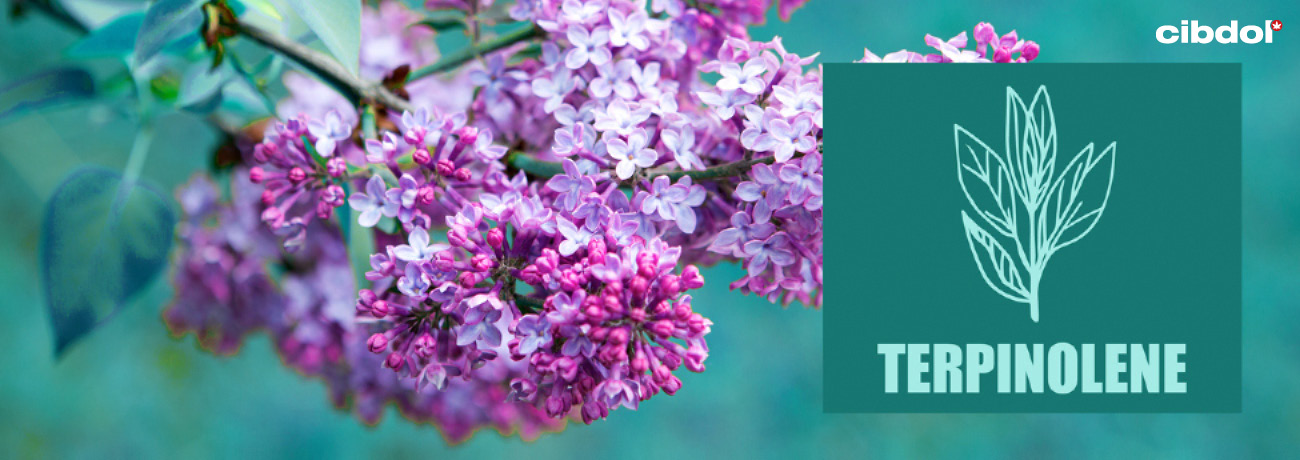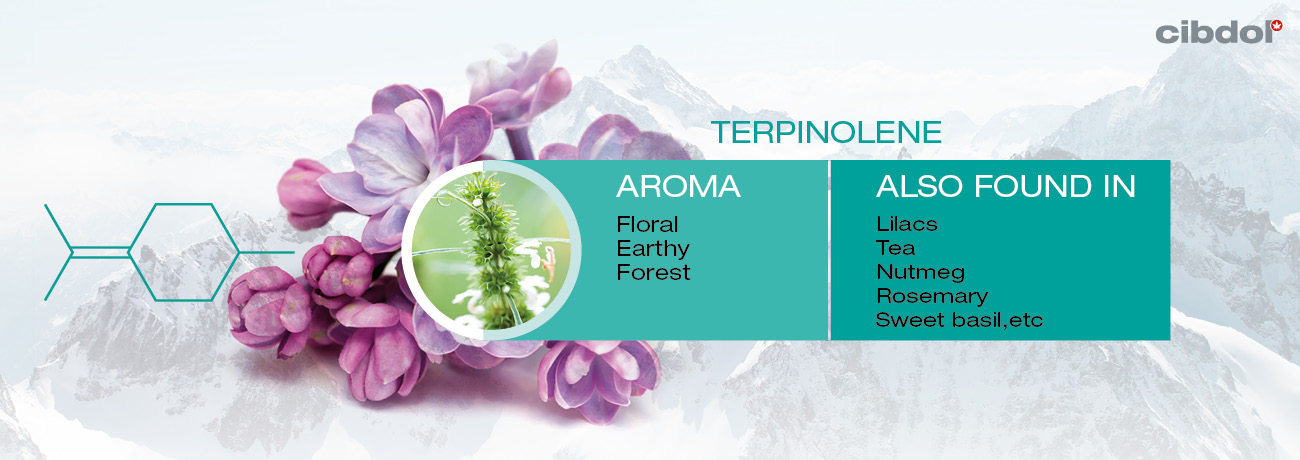Ce este terpinolenul?

Terpinolena (terpinenul) este una dintre cele peste 200 de terpene produse de planta de canabis. Molecula apare în multe chemotipuri moderne de canabis - deși în cantități relativ mici în comparație cu alți membri ai aceleiași clase chimice. Cercetătorii remarcă faptul că terpena apare mai ales în soiurile de tip sativa[1].
Ca o monoterpenă, terpinolena este o moleculă mică și simplă. Două unități de izopren îi definesc structura moleculară și o plasează în această categorie, alături de limonen și mircen.
În ciuda prezenței sale în cantități mici, terpinolena (terpinenul) contribuie totuși semnificativ la aroma de ansamblu a multor tulpini de canabis - o mărturie clară a mirosului său înțepător. Dar parfumul său puternic nu a fost dezvoltat doar pentru plăcerea senzorială a oamenilor.
Plantele de canabis produc terpinolenă - alături de o mulțime de alte terpene și canabinoizi - pentru a se apăra împotriva insectelor dăunătoare și patogenilor fungici, datorită capacității larvicide și antifungice a moleculei.
Poate că este o moleculă mică, dar este plină de promisiuni. Cercetările științifice continuă să descopere potențialul terapeutic al terpinolenei. Deși majoritatea descoperirilor sunt abia la început, este posibil ca terpinolena să fie un jucător major în viitorul științei canabisului.
Hai să ne uităm la caracteristicile terpinolenei și să vedem ce au de spus despre ea cele mai recente cercetări.
Aromă
Terpinolena captează aromele pădurii. În câteva cuvinte: terpena are un parfum de pământ, proaspăt, oferind note distincte de pin, lemn, flori și ierburi și note subtile de citrice. Este ușor de înțeles de ce companiile utilizează această substanță chimică atunci când prepară produse precum săpunuri și parfumuri.
Prezentă și în
Terpinolena apare în diverse specii de plante din natură. Este prezentă în diferite concentrații în arborele de ceai cu frunze înguste, țelină, pin scoțian, nucșoară, măghiran dulce, valeriană, oregano, coriandru, rozmarin, busuioc dulce, salvie și ghimbir.
Păstârnacul sălbatic conține cele mai mari niveluri de terpinolenă din natură. Uleiul esențial din această plantă conține această substanță chimică într-o concentrație de aproximativ 69%.
Posibile efecte
La fel ca mulți alți compuși prezenți în planta de canabis, terpinolena produce câteva efecte terapeutice interesante. Cu toate acestea, ne aflăm abia în primele etape ale cercetărilor. Există o lipsă distinctă de studii clinice umane.
Chiar și așa, studiile celulare și pe animale ne oferă o privire asupra a ceea ce ar putea dezvălui cercetările viitoare referitoare la terpinolenă.
Până acum, se pare că terpinolena produce următoarele efecte:
• Antitumoral
• Antioxidant
• Analgezic
• Antiinflamator
• Posibil sedativ
• Poate proteja împotriva bolilor cardiovasculare
Cercetările de sprijin
Mai multe studii au demonstrat potențialul antitumoral al terpinolenei. Molecula pare să modifice căile de semnalizare care determină supraviețuirea și creșterea celulelor canceroase. Cercetări[2] publicate în jurnalul Oncology Letters documentează modul în care terpinolena produce aceste efecte.
Studiul a constatat că terpena este eficientă în reducerea expresiei unei proteine kinază, denumită AKT. Cunoscută și sub denumirea de proteină kinază B, AKT contribuie la progresia cancerului prin medierea proliferării celulelor și a semnalelor de supraviețuire. Prin urmare, este logic că o expresie crescută a AKT-ului să fie implicată în numeroase tipuri de cancer uman.
Interesant este faptul că cercetătorii au descoperit că celulele tratate cu extract de salvie sau de rozmarin prezintă o expresie scăzută a proteinei kinază. În urma investigaților suplimentare, s-a descoperit că terpinolena - un compus activ al ambelor specii de plante - este capabilă să producă aceste efecte.
Cercetări suplimentare[3], publicate în 2013, au testat terpinolena cu privire la proliferarea celulelor tumorale în creierul de șobolan. Cercetătorii au descoperit că terpena produce efecte semnificative atunci când este administrată celulelor neuroblastomului. Aceștia au ajuns la concluzia că terpinolena produce efecte antiproliferative puternice și poate avea o potențială utilizare ca agent anticancerigen.
Terpinolena poate avea și potențial ca antioxidant. Cercetări[4] publicate în jurnalul Cytotechnology și-au propus să testeze efectele moleculei asupra limfocitelor umane - un subtip de celule albe din sânge.
Cercetătorii au expus celulele la terpenă pentru perioade de 24 și 48 de ore. Aceștia au descoperit activitate antioxidantă, fără efecte genotoxice. Astfel, au ajuns la concluzia că terpinolena ar putea fi o „nouă resursă terapeutică” datorită activităților sale antioxidante.
Terpinolena poate ajuta la reducerea atât a durerii, cât și a umflăturii. Un studiu din 2016[5] publicat în Brazillian Journal of Medical and Biological Research a descoperit că terpena interacționează pozitiv cu medicamentele antiinflamatoare comune.
Cercetătorii au administrat șoarecilor un amestec de terpinolenă și medicamentul antiinflamator nesteroidian (AINS) Diclofenac. Combinația a scăzut nivelurilor biomarkerilor inflamației și ale durerii, posibil prin acționarea asupra receptorilor serotoninei. Mai mult decât atât, cele două substanțe chimice au produs aceste efecte fără a provoca leziuni gastrice - un efect secundar al AINS.
Juriul încă nu s-a decis dacă terpinolena produce efecte sedative sau stimulante. Cercetările[6] au descoperit că o doză de doar 0,1 mg a redus activitatea motorie cu 67,8%. Dacă viitoare studii umane vor prezenta rezultate similare, terpinolena ar putea juca un rol benefic în afecțiuni precum anxietatea și insomnia.
În cele din urmă, cercetările curente[7] sugerează că terpinolena ar putea ajuta la protejarea împotriva anumitor afecțiuni cardiovasculare. Molecula poate contribui la protejarea împotriva oxidării lipoproteinei cu densitate scăzută (LDL). Cunoscut drept tipul de colesterol „rău”, LDL se poate acumula în artere și poate contribui la atacuri de cord și atacuri vasculare cerebrale.
Oxidarea LDL - cauzată de radicalii liberi - poate provoca rigidizarea arterelor. Prin reducerea oxidării LDL-ului, terpinolena poate contribui la prevenirea unor astfel de boli.
[1] Hazekamp, A., Tejkalová, K., & Papadimitriou, S. (2016). Cannabis: From Cultivar to Chemovar II—A Metabolomics Approach to Cannabis Classification. Cannabis and Cannabinoid Research, 1(1), 202–215. https://doi.org/10.1089/can.2016.0017 [Referinţă]
[2] OKUMURA, N., YOSHIDA, H., NISHIMURA, Y., KITAGISHI, Y., & MATSUDA, S. (2011). Terpinolene, a component of herbal sage, downregulates AKT1 expression in K562 cells. Oncology Letters, 3(2), 321–324. https://doi.org/10.3892/ol.2011.491 [Referinţă]
[3] Aydin, E., Türkez, H., & Geyikoğlu, F. (2013). Antioxidative, anticancer and genotoxic properties of α-pinene on N2a neuroblastoma cells. Biologia, 68(5), 1004–1009. https://doi.org/10.2478/s11756-013-0230-2 [Referinţă]
[4] Turkez, H., Aydin, E., & Geyikoglu, F. (2014). Genotoxic and oxidative damage potentials in human lymphocytes after exposure to terpinolene in vitro. Springer Link. https://link.springer.com/article/10.1007/s10616-014-9698-z [Referinţă]
[5] Macedo, E., Santos, W., Sousa Neto, B., Lopes, E., Piauilino, C., Cunha, F., Sousa, D., Oliveira, F., & Almeida, F. (2016). Association of terpinolene and diclofenac presents antinociceptive and anti-inflammatory synergistic effects in a model of chronic inflammation. Brazilian Journal of Medical and Biological Research, 49(7). https://doi.org/10.1590/1414-431x20165103 [Referinţă]
[6] Russo, E. B., & Marcu, J. (2017). Cannabis Pharmacology: The Usual Suspects and a Few Promising Leads. Cannabinoid Pharmacology, 67–134. https://doi.org/10.1016/bs.apha.2017.03.004 [Referinţă]
[7] Graßmann, J., Hippeli, S., Spitzenberger, R., & Elstner, E. (2005). The monoterpene terpinolene from the oil of Pinus mugo L. in concert with α-tocopherol and β-carotene effectively prevents oxidation of LDL. Phytomedicine, 12(6–7), 416–423. https://doi.org/10.1016/j.phymed.2003.10.005 [Referinţă]
[1] Hazekamp, A., Tejkalová, K., & Papadimitriou, S. (2016). Cannabis: From Cultivar to Chemovar II—A Metabolomics Approach to Cannabis Classification. Cannabis and Cannabinoid Research, 1(1), 202–215. https://doi.org/10.1089/can.2016.0017 [Referinţă]
[2] OKUMURA, N., YOSHIDA, H., NISHIMURA, Y., KITAGISHI, Y., & MATSUDA, S. (2011). Terpinolene, a component of herbal sage, downregulates AKT1 expression in K562 cells. Oncology Letters, 3(2), 321–324. https://doi.org/10.3892/ol.2011.491 [Referinţă]
[3] Aydin, E., Türkez, H., & Geyikoğlu, F. (2013). Antioxidative, anticancer and genotoxic properties of α-pinene on N2a neuroblastoma cells. Biologia, 68(5), 1004–1009. https://doi.org/10.2478/s11756-013-0230-2 [Referinţă]
[4] Turkez, H., Aydin, E., & Geyikoglu, F. (2014). Genotoxic and oxidative damage potentials in human lymphocytes after exposure to terpinolene in vitro. Springer Link. https://link.springer.com/article/10.1007/s10616-014-9698-z [Referinţă]
[5] Macedo, E., Santos, W., Sousa Neto, B., Lopes, E., Piauilino, C., Cunha, F., Sousa, D., Oliveira, F., & Almeida, F. (2016). Association of terpinolene and diclofenac presents antinociceptive and anti-inflammatory synergistic effects in a model of chronic inflammation. Brazilian Journal of Medical and Biological Research, 49(7). https://doi.org/10.1590/1414-431x20165103 [Referinţă]
[6] Russo, E. B., & Marcu, J. (2017). Cannabis Pharmacology: The Usual Suspects and a Few Promising Leads. Cannabinoid Pharmacology, 67–134. https://doi.org/10.1016/bs.apha.2017.03.004 [Referinţă]
[7] Graßmann, J., Hippeli, S., Spitzenberger, R., & Elstner, E. (2005). The monoterpene terpinolene from the oil of Pinus mugo L. in concert with α-tocopherol and β-carotene effectively prevents oxidation of LDL. Phytomedicine, 12(6–7), 416–423. https://doi.org/10.1016/j.phymed.2003.10.005 [Referinţă]







